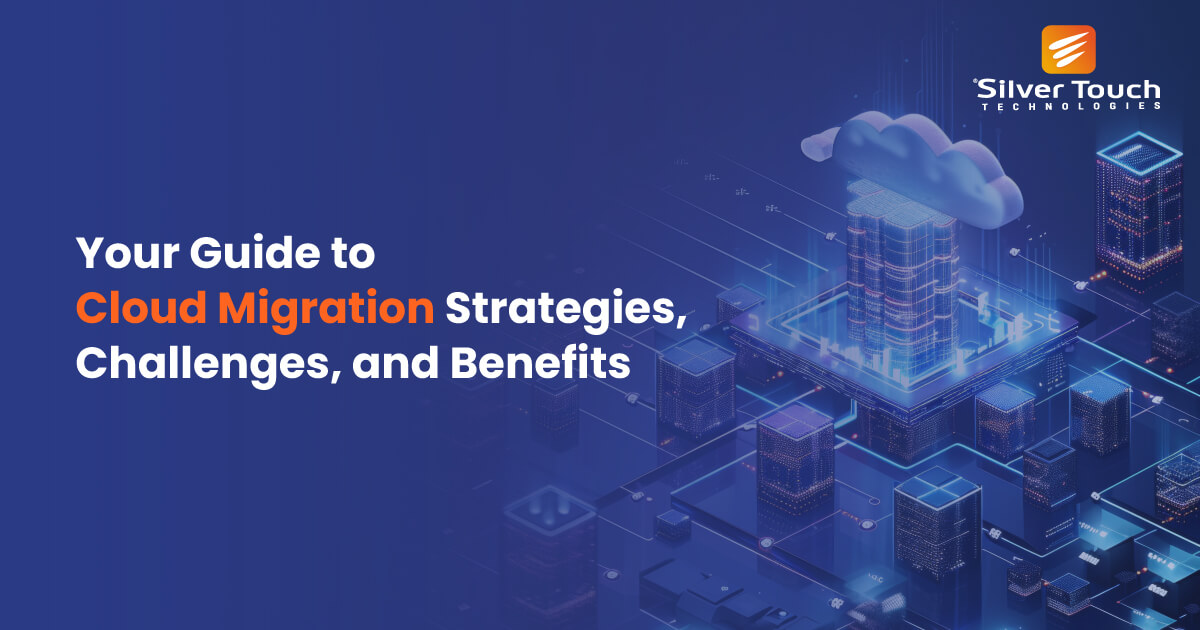Table Of Content
The recent shift to remote working, increasing competition, and ever-changing expectations compel businesses to switch from legacy to digital systems. These are the reasons startups and small businesses also find a way to bring digital transformation through technology. Here, you can count on cloud migration consulting services. It can help you leverage the benefits of a revolutionary cloud concept including reduced costs and quicker access to business apps.
In this post, we will understand the factors that lead to cloud migration along with challenges and business benefits. Let’s start with a definition and types of on-premise to cloud migration.
Definition and Types of Cloud Migration
Cloud migration is the process of transferring various business applications, corporate data, and other IT processes to a cloud-based environment. Cloud migration service providers can assist small businesses in on-premise to cloud migration. One of the biggest cloud migration benefits is businesses can take a ‘pay-as-you-go’ model based on consumption. It provides higher flexibility cost-effectively.
Cloud migration managed service providers have categorized 7 different approaches for the process. These 7 'R's are the following strategies for the migration process-
- Rehost (Lift and Shift)
This approach involves moving an application to the cloud without making any changes to the application itself. It is the quickest approach but does not offer many benefits to companies. - Refactor (Re-architect)
This concept is about redesigning an application completely to leverage cloud-native services and infrastructure. Though it is highly time-consuming, it often yields the highest benefits. - Revise
It is about making minor modifications to your business application to optimize its performance in the cloud. This is a middle-ground approach between Rehost and Refactor. - Rebuild
This concept focuses on creating a new application with similar functionality using cloud-native technologies. This concept is useful when the original application is outdated. - Replace
As per this concept, cloud migration service providers substitute an existing application with a cloud-based Software-as-a-Service (SaaS) equivalent. This is a quick and cost-effective option. - RetainThis approach is useful when the company wants to keep an application on-premises due to specific reasons like regulatory compliance.
- Retire
It is the complete discontinuation of an application. When your application is no longer required, you can opt for this concept.
Let’s review some common triggers for migrating your legacy business system to the cloud.
Read more: Your Guide to Azure Cloud Migration
Common Triggers for Cloud Migration
Entrepreneurs jump on the cloud migration bandwagon for various rasons. Some of the triggers for migrating your existing business applications and system to the cloud include-
- Business Growth
As businesses expand, the existing IT infrastructure faces more load. Cloud migration can provide the necessary scalability to accommodate increased workloads and data volumes.
- Cost Savings
Another noteworthy reason for migrating to the cloud is it can reduce various costs substantially. Cloud-based data centers are more cost-efficient than on-premise data centers.
- Enhanced Security
Cloud migration consulting services can help you enhance the security of corporate data. Providers invest heavily in security infrastructure to protect data from cyber threats.
Need for Scalability and Flexibility
On-premise to cloud migration is useful for higher scalability, enabling organizations to rapidly increase or decrease resources. It is useful for handling more spikes or new product launches.
Cloud migration can help companies keep up with the future. However, it is better to contact a reputed cloud migration consulting services provider to leverage its benefits.
Key Steps in the Cloud Migration Process

Cloud migration is a complex process and we can segregate it into four steps. These steps are-
- Discovery and Assessment
It is an initial phase that includes identifying business apps and databases. It also assesses the dependencies of the application. Moreover, this stage determines the size and necessity of corporate data to be migrated. Once your company identifies clear goals for cloud migration, you can go for the second stage, i.e. planning.
- Migration Planning
Making a blueprint for a migration process is a crucial stage. It involves the selection of the right platform based on workload characteristics. Moreover, a proper selection of migration approaches like rehosting or refactoring is necessary. Here, a cloud migration managed services provider can give a migration timeline and create necessary plans.
- Execution
It is a real process of migrating your applications and business data. Here, the provider establishes the cloud infrastructure after considering your business needs and approach. The next step after migrating applications to the cloud is their testing and validation. Whenever issues or challenges are present, your migration partner can take the necessary action.
- Post-Migration
Post-migration support is crucial for leveraging the benefits of the cloud. This step includes cost management, security, and compliance management, and continuous monitoring with optimization of cloud resources. Most providers offer post-migration training support, however, it is better to ask in advance.
When a cloud migration managed services provider follows these steps, your company can get several benefits.
Benefits of Cloud Migration for Your Business
Cloud migration offers a multitude of benefits to modern businesses. Here we mention some of them-
- Cost Reduction
Cloud computing offers a 'pay-as-you-use' model. It can assist your company to get rid of expenses related to hardware, software licenses, and maintenance. Moreover, you can get an advantage of optimum resource utilization and simplified IT management.
- Improved Scalability
Whenever your business needs higher scalability to handle spikes in web traffic, cloud-powered resources remain ready. Moreover, you can reduce time-to-market by deploying new applications quickly. Cloud migration can keep your business ready for the future.
- Enhanced Performance
It is possible to get the benefit of robust infrastructure, especially during any disaster. Your company can get improved performance of applications with faster processing and reduced response times. Furthermore, cloud-powered migration can give access to advancements.
- More Security
Whether it is Azure cloud migration services or other platform-based services, you can always get the advantage of robust security features and compliance standards. Moreover, you can protect sensitive information using end-to-end encryption and other techniques.
- Improved Collaboration
The cloud-based platforms can facilitate teamwork and knowledge-sharing. It further results in higher employee productivity. You can also manage remote work and get access to data from anywhere. Such improved collaboration can assist you in streamlining business processes.
- Data-Driven Decisions
Cloud-driven data analytics tools can offer valuable insights from your business data. Your company can get better business intelligence and make informed decisions in real time. You can contact cloud migration consulting services to identify trends and opportunities in the cloud.
Cloud migration consulting services can assist you in leveraging these benefits without spending a lot of money. These services focus on cloud migration challenges. Let's dig in.
Addressing Common Cloud Migration Challenges
Cloud migration is challenging and brings some hurdles. Let's understand these challenges to ensure a successful migration-
- Data Security and Compliance
Moving your business data to the cloud introduces new security challenges such as data breaches, unauthorized access, and violations of compliance. Organizations, therefore, need to implement robust security measures including encryption, access controls, etc.
- Application Modernization
Many organizations still rely on legacy applications. Modernizing these applications to leverage cloud benefits can be time-consuming and resource-intensive. It requires careful assessment and planning to determine the optimal approach for making these apps advanced.
- Managing Costs
Organizations need to understand cloud pricing models, optimize resource utilization, and implement cost-saving strategies. It is necessary to have proper cost management with continuous monitoring and analysis of usage of cloud-driven resources.
- Legacy Application Compatibility
Compatibility of legacy applications with cloud infrastructure always poses a challenge. Organizations may need to invest in application modernization or find alternative solutions to ensure seamless cloud integration. Careful assessment of application dependencies is crucial.
- Downtime and Business Continuity
The risk of downtime or disruptions looms large when it comes to cloud-based platforms. Your trusted cloud migration managed services provider can help you with contingency plans and higher uptime. It can ensure business continuity even during the time of disaster.
- Business Support
Resistance to change and lack of employee training can restrict the adoption of cloud technology. Companies should communicate the benefits of cloud migration properly and ensure that all employees get the necessary training.
Why SilverTouch is the Best Suited for Reliable Cloud Migration
Silver Touch Technologies Canada is your trusted cloud migration consulting services provider. We offer a 360-degree solution for migrating business data and our expert professionals ensure that your company can leverage the advantage cost-effectively. Our Silver Cloud solution is designed to maximize efficiency and improve overall performance.
We offer our esteemed corporate clientele 24×7 cloud infrastructure monitoring and managed NOC services with 99.9% uptime. We can also help your business leverage the benefits of SAP Business One and other BI applications. Contact us to discuss cloud migration requirements.
FAQs
Cloud migration services are useful for companies to move business applications and data from on-premises infrastructure to a cloud platform.



